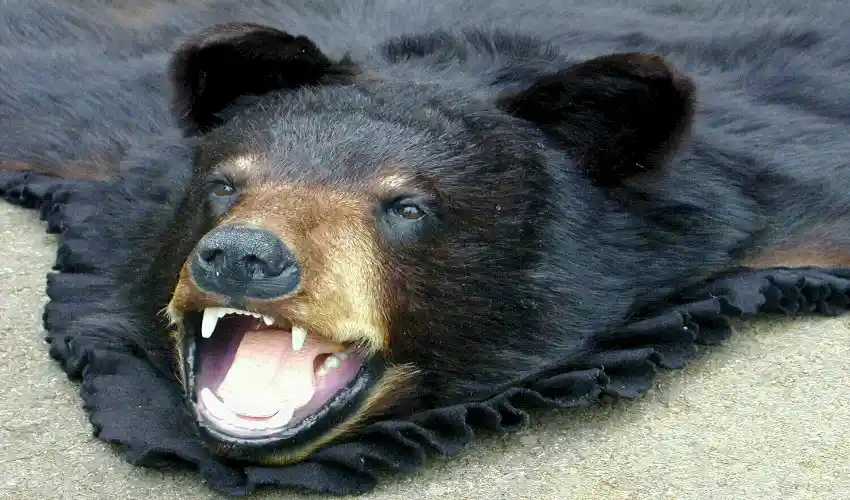Bear skin rugs have long been associated with opulence, luxury, and status. Often displayed in grand homes or hunting lodges, these rugs can instantly elevate a room’s aesthetic, providing a striking contrast to typical furnishings. But what exactly makes bear skin rugs so luxurious? From their rarity to the craftsmanship involved in creating them, there are several key factors that contribute to their high-end status. In this article, we will explore why bear skin rugs are regarded as luxury items, examining their history, value, and unique qualities.
- Historical Significance
Historically, bear skin rugs were symbols of wealth and power. In ancient cultures, including the Vikings and Native Americans, bears were seen as mighty creatures and hunting them was a difficult and dangerous endeavor. Displaying a bear skin was not only a way to show prowess in the hunt but also a marker of high social standing. These rugs, therefore, became prized possessions that indicated a person’s success and their connection to the natural world’s most fearsome predator.
The association with royalty and aristocracy further cemented the bear rug for sale position as a luxury item. Kings, nobles, and wealthy landowners would showcase their hunting trophies, which often included bear skins, in their estates or castles. This practice continued into the 19th and early 20th centuries, when bear skin rugs were featured in the homes of the elite.
- Rarity and Exclusivity
One of the key reasons bear skin rugs are considered luxury items is their rarity. Bears, especially large ones like grizzly bears and black bears, are not easy to hunt. Unlike other animals, such as sheep or deer, which are more common and widely available, bears are elusive creatures that inhabit remote areas. This makes acquiring a bear skin a challenging and time-consuming endeavor.
Additionally, in many regions, bear hunting is regulated or prohibited to protect bear populations. Laws surrounding hunting seasons, quotas, and licenses add to the rarity and exclusivity of bear skin rugs. As a result, acquiring an authentic bear skin rug requires either significant effort or considerable financial investment, further enhancing its status as a luxury item.
- Craftsmanship and Labor-Intensive Process
Creating a bear skin rug is a meticulous and labor-intensive process. The skin must be carefully tanned to preserve its softness and durability while retaining its natural beauty. The tanning process involves various steps, including cleaning, stretching, and drying the hide to ensure it maintains its shape and texture.
The preparation of a bear skin rug requires a high level of skill and expertise. Craftsmen who specialize in this work must have a deep understanding of the tanning process and how to properly mount the skin to preserve its integrity. Additionally, the size and weight of the bear’s hide make this process much more complex than creating rugs from smaller animals, such as deer or foxes. As a result, bear skin rugs often command a higher price due to the time, effort, and skill required to craft them.
- Aesthetic Appeal
Beyond their historical and practical value, bear skin rugs are prized for their aesthetic appeal. The size and striking appearance of the bear skin create a bold statement piece in any room. The texture and colors of the fur are rich and visually stunning, adding a sense of luxury and elegance to a space.
Bear skin rugs are often used as the centerpiece of a room, placed on the floor or hung on a wall as a decorative element. The natural beauty of the hide, with its thick fur and striking pattern, creates a unique focal point that enhances the overall design of the space. For homeowners looking to add a touch of rustic sophistication or hunting-themed décor, a bear skin rug is the perfect choice.
- Symbol of Status and Wealth
Owning a bear skin rug has long been a symbol of status and wealth. In a time when hunting was a popular pastime for the elite, displaying a bear skin rug was a way for individuals to showcase their hunting prowess and their ability to acquire rare and expensive items. Even today, the bear skin rug continues to serve as a status symbol, often found in luxury homes, hunting lodges, and private estates.
The association between bear skin rugs and the wealthy is reinforced by the high price tag attached to these items. Due to their rarity, craftsmanship, and the time involved in acquiring and preparing the skin, bear skin rugs can cost thousands of dollars. This price makes them inaccessible to the average consumer, further elevating their status as luxury items.
- Cultural and Ecological Considerations
While bear skin rugs are often seen as luxury items, it is important to note the ethical and ecological concerns surrounding their acquisition. The rise of conservation efforts and increased awareness about endangered species has led to stricter regulations on hunting, making bear skins even rarer. Many people now prefer to purchase faux bear skin rugs or choose sustainable alternatives that do not involve hunting.
Despite these concerns, the allure of bear skin rugs remains strong, with many collectors still valuing the authenticity and history behind these unique pieces. Whether used for their aesthetic appeal, historical significance, or sheer rarity, bear skin rugs continue to occupy a prestigious place in the world of luxury decor.
Conclusion
Bear skin rugs are regarded as luxury items for several reasons. Their historical significance, rarity, and the labor-intensive process involved in creating them all contribute to their high-end status. Moreover, their aesthetic appeal and association with wealth and prestige have made them a symbol of opulence. Whether displayed as a trophy of the hunt or as a statement piece in a luxury home, a bear skin rug is more than just a decoration—it’s a piece of history and a symbol of affluence. As such, it remains a sought-after luxury item in the world of interior design.
